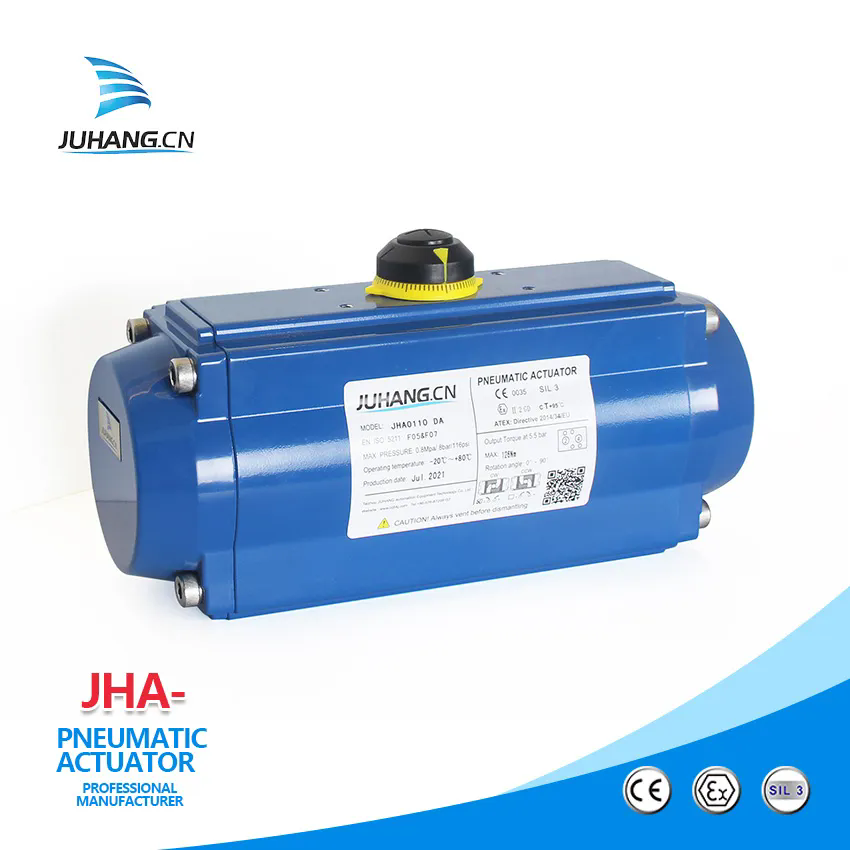Unlocking Efficiency: The Role of Pneumatic Valve Actuators in Modern Automation
2024-08-07
In the realm of industrial automation and control systems, pneumatic valve actuators are indispensable components that help manage and control the flow of fluids and gases. These devices convert compressed air into mechanical motion to operate valves, enabling precise control over various processes. In this blog, we’ll explore what pneumatic valve actuators are, their key benefits, and their applications in modern industries.
1. What is a Pneumatic Valve Actuator?
A pneumatic valve actuator is a device that uses compressed air to move a valve, controlling the flow of fluids or gases within a system. It typically consists of a cylinder that houses a piston connected to the valve stem. When compressed air is applied to the actuator, it moves the piston, which in turn operates the valve to open or close. Pneumatic valve actuators are commonly used in automated systems where precise control of flow is essential.
2. Key Benefits of Pneumatic Valve Actuators
- Rapid Response Time: Pneumatic valve actuators are known for their quick response times. They can actuate valves rapidly, which is crucial for processes that require swift adjustments to flow rates or pressure.
- Simplicity and Reliability: These actuators are relatively simple in design and operation. They rely on compressed air, which is readily available in most industrial settings, making them a reliable choice for various applications.
- Cost-Effectiveness: Pneumatic actuators are generally more cost-effective compared to electric or hydraulic actuators. Their straightforward design and use of compressed air contribute to lower initial costs and reduced maintenance expenses.
- Durability: Pneumatic valve actuators are built to withstand harsh industrial environments. They are resistant to high temperatures, corrosive substances, and mechanical wear, making them suitable for demanding applications.
- Ease of Maintenance: The simplicity of pneumatic actuators means they are relatively easy to maintain. Regular maintenance typically involves checking for leaks, ensuring proper air pressure, and inspecting the actuator for wear.
3. Types of Pneumatic Valve Actuators
- Single-Acting Actuators: These actuators use compressed air to move the valve in one direction (e.g., opening the valve) and rely on a spring to return the valve to its original position. Single-acting actuators are commonly used in applications where one-direction control is sufficient.
- Double-Acting Actuators: Double-acting actuators use compressed air to move the valve in both directions (e.g., opening and closing the valve). They offer more precise control and are ideal for applications that require bidirectional movement.
- Linear Actuators: Linear pneumatic actuators provide straight-line motion to operate linear valves. They are often used in applications where precise control over linear movement is required.
- Rotary Actuators: Rotary pneumatic actuators provide rotational motion to operate quarter-turn valves such as ball valves and butterfly valves. They are ideal for applications that require rotational control of the valve.
4. Applications of Pneumatic Valve Actuators
- Manufacturing and Production: In manufacturing and production facilities, pneumatic valve actuators control the flow of raw materials, water, air, and other substances. They are used in processes such as mixing, blending, and transferring materials.
- Water Treatment: Pneumatic actuators are employed in water treatment plants to manage the flow of water and chemicals through various stages of the treatment process. They help control the distribution of water and ensure effective treatment.
- Chemical Processing: In chemical processing industries, pneumatic valve actuators regulate the flow of chemicals, reactants, and by-products. They are used in processes that require precise control over the flow of corrosive or hazardous substances.
- Oil and Gas: Pneumatic actuators are used in the oil and gas industry to control the flow of oil, gas, and other fluids in pipelines, refineries, and processing plants. They help manage pressure and flow rates in these critical applications.
- HVAC Systems: In heating, ventilation, and air conditioning (HVAC) systems, pneumatic valve actuators control the flow of air and fluids to regulate temperature, humidity, and airflow.
5. Choosing the Right Pneumatic Valve Actuator
When selecting a pneumatic valve actuator, consider the following factors:
- Valve Type and Size: Match the actuator to the type and size of the valve it will operate. Ensure the actuator can handle the valve's required torque and movement.
- Air Pressure: Verify that the actuator is compatible with the available air pressure in your system. Different actuators have different pressure requirements.
- Environmental Conditions: Consider the operating environment of the actuator. Choose a model that is resistant to temperature extremes, moisture, and corrosive substances if needed.
- Control Requirements: Determine whether you need a single-acting or double-acting actuator based on the control requirements of your application.
- Maintenance Needs: Select an actuator that aligns with your maintenance capabilities and frequency. Look for models that are easy to inspect and maintain.
Conclusion
Pneumatic valve actuators are essential components in modern automation and industrial systems. Their ability to provide rapid, reliable, and cost-effective control of valves makes them invaluable for a wide range of applications. By understanding the key benefits, types, and applications of pneumatic valve actuators, you can make informed decisions about integrating them into your systems to enhance efficiency and performance. Whether you’re in manufacturing, water treatment, or any other industry, pneumatic valve actuators play a crucial role in ensuring smooth and precise control of fluid and gas flow.



